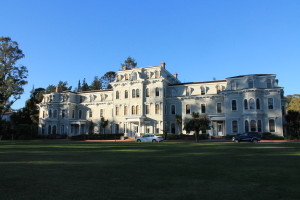
A two minute walk from the 24th Street Mission BART station lies a tiny joint called Prubechu, nestled between Mi Yucatan and Rent-A-Center, that you could almost miss if you were not looking for it.
As I entered Prubechu for the first time, the only Chamorro restaurant in San Francisco, I was filled with a rush of homecoming. As a Chamorro from the Pacific island of Guam, a minority within minorities, I’m always searching for my people, for a connection to the island that raised me and keeps me rooted.
Prubechu means “welcome” in both Spanish and Chamorro, a testament to the history of Spanish colonization of the Mariana islands.
The restaurant does not start seating diners until 5 p.m., and I caught the chef, Shawn Naputi, prepping food while Shawn Camacho, Prubechu’s general manager, welcomed me with a warm “Hafa Adai,” the Chamorro greeting.
“What’s Guam food?” Camacho mused as the kitchen behind him rustled to life. “We still have a hard time explaining it to people because we have the Spanish influence, the Asian influence, and the native traditions that date from pre-colonization.”
People from all over the Bay Area descend upon Prubechu for food that packs a hearty punch of story, culture and roots. Naputi and Camacho explained that their restaurant has ignited a sense of pride and mixed emotions from diasporic Chamorros living in the Bay Area.
One customer at Prubechu, a manåmko’ (Chamorro for elder), said he left Guam shortly after the Japanese occupation in World War II. The man was traumatized by the loss of his family and land, and had not returned to Guam since the end of the war. When he visited Prubechu, the taste of tuba (fermented coconut sap) brought him to tears as he recalled stories of his younger sister, who was killed during the occupation.
“That’s the power of food,” Camacho said.
“People put their own lives into the food,” Naputi added. “They remember, ‘Oh, my grandma used to make this!’”
Another manåmko’ brought the co-owners a rare edition of a Chamorro language dictionary. Camacho placed the red bound book on the bar in front of me. Naputi flipped through the pages, pointing out a passage that demonstrates nginge’, the Chamorro cultural practice of bowing your head to sniff an elder’s hand in order to take in the essence of their spirit.
I ask them what kind of reaction Prubechu has gotten from Californians.
“The first thing that people do,” Camacho said, “is use their phones to locate Guam on Google Maps. They say, ‘Oh, it’s so tiny!””
But despite their unfamiliarity with its native homeland, customers end up loving both the food and cultural education they receive at Prubechu.
Chamorro food is ocean-centric, featuring island ingredients such as coconut meat, shellfish and citrus. Uniquely, Chamorro food is mixed in with Spanish, Mexican, American and Filipino colonial overtones.
“When I was growing up, I thought lumpia and pancit were native Chamorro dishes,” Naputi said, referring to the traditional Filipino dishes.
Naputi pointed out that Yelp classifies Prubechu’s cuisine as “ethnic food” and “Asian fusion.”
“They refuse to say Chamorro food. Why would they add another food category when our place is the only one out there?”
This points to a feeling of invisibility that many Chamorros in the Bay Area experience, both men agreed. When I asked what ethnicity Californians think Naputi and Camacho are, they laughed and exchanged glances.
“Mexicans think I’m Asian because my eyes are bachigo’ (slanted) and Asians think [that] I’m Filipino,” Camacho said.
As a mixed race Chamorro with bachigo’ eyes, I can relate to this.
Camacho and Naputi acknowledged that the multicultural hybridity that is prevalent on Guam is due to centuries of colonization and proximity to other countries in Asia-Pacific. While Chamorro food and culture was built upon centuries of colonial influences, the indigenous culture of sincere generosity, fierce loyalty and resilience was preserved. Prubechu offers native islanders and newbies alike a distinct experience that stands out like a patch of island sun and breeze amidst San Francisco’s foggy streets.



